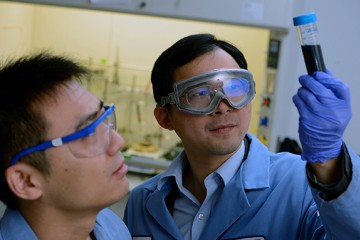A team of engineers from the Department of Chemical and Biomolecular Engineering have received a $1.9 million grant from the Department of Energy to develop a new exhaust-gas catalyst system that will dramatically reduce emissions for automobiles, power plants, and other industrial processes.
The funding, which expands an existing DOE grant, will support Marc Donohue, Chao Wang, and principal research scientist Gregory Aranovich as they work to produce a commercially viable system that kicks in just after an engine turns on, allowing it to begin mitigating emissions when the engine is running rich and emissions are at their highest. Current emissions systems have higher "light-off" temperatures, so they are ineffective until the exhaust catalyst has become hot.
"This discovery may represent a paradigm shift in understanding catalytic behavior and potentially could significantly increase the rates of many catalytic processes of industrial interests," Donohue said.
What sets the proposed system apart from existing systems is its use of adsorption compression, which is the sudden increase in pressure amongst molecules on the surface of the exhaust gas. This high pressure—1,000 to 50,000 times higher than the pressure within the gas phase—dramatically increases catalytic activity, allowing the catalytic reactions required for emission reduction to occur at much lower temperatures than usual. In their research, the team used nano-porous catalysts such as zeolites to decompose nitric oxide from exhaust gas streams; NO is a major pollutant that is produced in almost all combustion processes.
The researchers applied a novel approach to designing both catalysts and catalytic operating conditions, using an entirely new method of data analysis to determine the active surface area and energy of adsorption compression. With the additional funding, they plan to expand their explorations of NO decomposition to other pollutants with the goal of producing a versatile exhaust-gas catalyst with a light-off temperature of less than 200 degrees Celsius (392 degrees Fahrenheit). They also hope to develop tools to dramatically improve other catalysts and catalytic processes using adsorption compression.
"The new catalysts to be developed in this project will substantially reduce emissions when we start our vehicles," Wang said. "The so-called cold-start emission has been a pivotal challenge for further cleaning of our atmosphere before full electrical vehicles take over our roads. The technology proposed here holds the potential to merge this gap."
Correction: The goal light-off temperature for the exhaust-gas catalyst researchers hope to produce was misstated in an earlier version of this article. The Hub regrets the error.
Posted in Science+Technology
Tagged emissions









